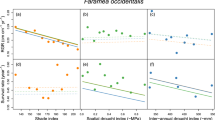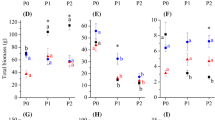Abstract
In mountain ecosystems, plant regeneration might be constrained by multiple factors that change along elevation gradients and promote traits differentiation. Drought is a strong filter for seedling establishment that might be modified by herbivory co-occurrence. Populations of the tree Maytenus boaria support lower soil moisture and higher herbivory pressure at low elevations than at mid-elevations in Córdoba Mountains, central Argentina. Consequently, we expect that populations from the low elevation perform better in response to drought than populations from mid-elevations and that herbivory modifies these responses. Seedlings from the two elevation origins were exposed to two levels of simulated drought and herbivory in a greenhouse experiment. The selected elevations corresponded to the lowest edge of species distribution (with driest soils and highest herbivory pressure) and the central mid-elevation. Performance-related variables, biomass allocation patterns and several morphological and physiological traits were measured. Mortality patterns and most of morphological and physiological variables showed that drought is a stressful factor at the regeneration stage of M. boaria. The drought effect was increased by simulated herbivory in some variables (LMF, RM:SM and SPAD). In most variables, origin did not influence seedling performance, suggesting that drought response of seedlings is independent of populations’ elevation. Only leaf number and water potential were in line with our predictions and showed an origin response to drought.




Similar content being viewed by others
References
Agrawal AA (2002) Herbivory and maternal effects: mechanisms and consequences of transgenerational induced plant resistance. Ecology 83(12):3408–3415
Anderegg WR, Hicke JA, Fisher RA, Allen CD, Aukema J, Bentz B, Hood S, Lichstein JW, Macalady AK, McDowell N, Pan Y, Raffa K, Sala A, Shaw JD, Stephenson NL, Tague C, Zeppel M (2015) Tree mortality from drought, insects, and their interactions in a changing climate. New Phytol 208(3):674–683
Barton KE, Hanley ME (2013) Seedling–herbivore interactions: insights into plant defence and regeneration patterns. Ann Bot 112(4):643–650
Barton KE (2016) Low tolerance to simulated herbivory in Hawaiian seedlings despite induced changes in photosynthesis and biomass allocation. Ann Bot 117(6):1053–1062
Barton KE, Shiels AB (2020) Additive and non-additive responses of seedlings to simulated herbivory and drought. Biotropica 52(6):1217–1228
Bhaskar R, Ackerly DD (2006) Ecological relevance of minimum seasonal water potentials. Physiol Plant 127(3):353–359
Chambers LE, Barnard P, Poloczanska ES, Hobday AJ, Keatley MR, Allsopp N, Underhill LG (2017) Southern hemisphere biodiversity and global change: data gaps and strategies. Austral Ecol 42(1):20–30
Chapin FS III, Autumn K, Pugnaire F (1993) Evolution of suites of traits in response to environmental stress. Am Nat 142:S78–S92
Giorgis MA, Cingolani AM, Teich I, Renison D, Hensen I (2010) Do Polylepis australis trees tolerate herbivory? Seasonal patterns of shoot growth and its consumption by livestock. Plant Ecol 207:307–319
Connolly J, Wayne P (1996) Asymmetric competition between plant species. Oecologia 108(2):311–320
Cotado A, Munné-Bosch S (2020) Distribution, trade-offs and drought vulnerability of a high-mountain Pyrenean endemic plant species Saxifraga Longifolia. Glob Ecol Conserv 22:e00916
Engelbrecht BM, Comita LS, Condit R, Kursar TA, Tyree MT, Turner BL, Hubbell SP (2007) Drought sensitivity shapes species distribution patterns in tropical forests. Nature 447(7140):80–82
Ferenc V, Merkert C, Zilles F, Sheppard CS (2021) Native and alien species suffer from late arrival, while negative effects of multiple alien species on natives vary. Oecologia 197(1):271–281
Fotovat R, Valizadeh M, Toorchi M (2007) Association between water-use efficiency components and total chlorophyll content (SPAD) in wheat (Triticum aestivum L.) under well-watered and drought stress conditions. J Food Agric Environ 5(3–4):225
García CL (2013) Utilización de información satelital y terrestre para el manejo integrado del recurso hídrico de una cuenca serrana en la Provincia de Córdoba, Argentina. PhD Theses, Universidad Nacional de Córdoba press. Córdoba: http://hdl.handle.net/11086/1659
Gassmann AJ (2004) Effect of photosynthetic efficiency and water availability on tolerance of leaf removal in Amaranthus hybridus. J Ecol 92:882–892
Gianoli E, González-Teuber M (2005) Environmental heterogeneity and population differentiation in plasticity to drought in Convolvulus chilensis (Convolvulaceae). Evol Ecol 19(6):603–613
Gurevitch J, Teeri JA, Wood AM (1986) Differentiation among populations of Sedum wrightii (Crassulaceae) in response to limited water availability: water relations, CO2 assimilation, growth and survivorship. Oecologia 70(2):198–204
Halbritter AH, Fior S, Keller I, Billeter R, Edwards PJ, Holderegger R, Karrenberg S, Pluess AR, Widmer A, Alexander JM (2018) Trait differentiation and adaptation of plants along elevation gradients. J Evol Biol 31(6):784–800
Harsch MA, Hulme PE, McGlone MS, Duncan RP (2009) Are treelines advancing? A global meta-analysis of treeline response to climate warming. Ecol Lett 12(10):1040–1049
He WM, Sun ZK (2016) Convergent production and tolerance among 107 woody species and divergent production between shrubs and trees. Sci Rep 6(1):1–7
IPCC (2014) Cambio climático 2014: Impactos, adaptación y vulnerabilidad. En: Resúmenes, preguntas frecuentes y recuadros multicapítulos. Contribución del Grupo de trabajo II al Quinto Informe de Evaluación del Grupo Intergubernamental de Expertos sobre el Cambio Climático. Field CB, Barros VR, Dokken DJ, Mach KJ, Mastrandrea MD, Bilir TE, Chatterjee M, Ebi KL, Estrada YO, Genova RC, Girma B, Kissel ES, Levy AN, MacCracken S, Mastrandrea PR, White LL (eds.). Organización Meteorológica Mundial, Ginebra
Keefover-Ring K, Rubert-Nason KF, Bennett AE, Lindroth RL (2016) Growth and chemical responses of trembling aspen to simulated browsing and ungulate saliva. J Plant Ecol 9(4):474–484
Khurana EKTA, Singh JS (2001) Ecology of seed and seedling growth for conservation and restoration of tropical dry forest: a review. Environ Conserv 28(1):39–52
Kitajima K, Fenner M (2000) Ecology of seedling regeneration. In: Fenner M (Ed), Seeds: the ecology of regeneration in plant communities (2nd edn), Wallingford, pp 331–359
Körner C (2012) Alpine treelines: functional ecology of the global high elevation tree limits. Springer Science & Business Media, Basel
Kuemmerle T, Altrichter M, Baldi G, Cabido M, Camino M, Cuellar E, Cuellar RL, Decarre J, Díaz S, Gasparri I, Gavier-Pizarro G, Ginzburg R, Giordano AJ, Grau HR, Jobbágy E, Leynaud G, Macchi L, Mastrangelo M, Matteucci SD, Noss A, Paruelo J, Piquer-Rodríguez M, Romero-Muñoz A, Semper-Pascual A, Thompson J, Torrella S, Torres R, Volante JN, Yanosky A, Zak M (2017) Forest conservation: remember Gran Chaco. Science 355(6324):465–465
Larter M, Pfautsch S, Domec JC, Trueba S, Nagalingum N, Delzon S (2017) Aridity drove the evolution of extreme embolism resistance and the radiation of conifer genus Callitris. New Phytol 215(1):97–112
Liu C, Liu Y, Guo K, Fan D, Li G, Zheng Y, Yu L, Yang R (2011) Effect of drought on pigments, osmotic adjustment and antioxidant enzymes in six woody plant species in karst habitats of southwestern China. Environ Exp Bot 71(2):174–183
López-Goldar X, Agrawal AA (2021) Ecological interactions, environmental gradients, and gene flow in local adaptation. Trends Plant Sci 26(8):796–809
Lorca EA, Ferreras AE, Funes G (2019) Seed size and seedling ontogenetic stage as modulators of damage tolerance after simulated herbivory in a woody exotic species. Aust J Bot 67(2):159–164
Marcora P, Hensen I, Renison D, Seltmann P, Wesche K (2008) The performance of Polylepis australis trees along their entire altitudinal range: implications of climate change for their conservation. Divers Distrib 14(4):630–636
Marcora PI, Renison D, País-Bosch AI, Cabido MR, Tecco PA (2013) The effect of altitude and grazing on seedling establishment of woody species in central Argentina. For Ecol Manage 291:300–307
Marcora PI, Tecco PA, Zeballos SR, Hensen I (2017) Influence of altitude on local adaptation in upland tree species from central Argentina. Plant Biol 19(2):123–131
McNaughton SJ (1983) Compensatory plant growth as a response to herbivory. Oikos 40(3):329–336
Moreira X, Petry WK, Mooney KA, Rasmann S, Abdala-Roberts L (2018) Elevational gradients in plant defences and insect herbivory: recent advances in the field and prospects for future research. Ecography 41(9):1485–1496
Ramos CS (2018) Interacciones biológicas y patrones espaciales de diversidad: plantas, artrópodos herbívoros y herbivoría en gradientes altitudinales. PhD Theses, Universidad de Buenos Aires press. Buenos Aires: https://bibliotecadigital.exactas.uba.ar/download/tesis/tesis_n6480_Ramos.pdf
RStudio Version 1.1.463 (2009–2018) RStudio, Inc. Mozilla/5.0 (Windows NT 6.1) AppleWebKit/538.1 (KHTML, like Gecko) rstudio Safari/538.1 Qt/5.4.1. http://www.rstudio.com
Rodríguez-Castañeda G, Dyer LA, Brehm G, Connahs H, Forkner RE, Walla TR (2010) Tropical forests are not flat: how mountains affect herbivore diversity. Ecol Lett 13(11):1348–1357
Rooke T (2004) Growth responses of a woody species to clipping and goat saliva. Afr J Ecol 41(4):324–328
Sánchez-Gómez D, Zavala MA, Valladares F (2008) Functional traits and plasticity linked to seedlings’ performance under shade and drought in Mediterranean woody species. Ann for Sci 65(3):311
Schneider CA, Rasband WS, Eliceiri KW (2012) NIH Image to ImageJ: 25 years of image analysis. Nat Methods 9(7):671–675
Scholander PF, Bradstreet ED, Hemmingsen EA, Hammel HT (1965) Sap pressure in vascular plants: negative hydrostatic pressure can be measured in plants. Science 148(3668):339–346
Stevens MT, Kruger EL, Lindroth RL (2008) Variation in tolerance to herbivory is mediated by differences in biomass allocation in aspen. Funct Ecol 22(1):40–47
Soliani C, Mattera M, Marchelli P, Azpilicueta M, Dalla-Salda G (2021) Different drought-adaptive capacity of a native Patagonian tree species (Nothofagus pumilio) resulting from local adaptation. Eur J Res 140(5):1147–1161
Taeger S, Sparks TH, Menzel A (2015) Effects of temperature and drought manipulations on seedlings of Scots pine provenances. Plant Biol 17(2):361–372
Tecco PA, Pais-Bosch AI, Funes G, Marcora PI, Zeballos SR, Cabido M, Urcelay C (2016) Mountain invasions on the way: Are there climatic constraints for the expansion of alien woody species along an elevation gradient in Argentina? J Plant Ecol 9(4):380–392
Teich I, Cingolani AM, Renison D, Hensen I, Giorgis MA (2005) Do domestic herbivores retard Polylepis australis Bitt: woodland recovery in the mountains of Córdoba, Argentina? For Ecol Manage 219(2–3):229–241
Thomson VP, Cunningham SA, Ball MC, Nicotra AB (2003) Compensation for herbivory by Cucumis sativus through increased photosynthetic capacity and efficiency. Oecologia 134(2):167–175
Varela SA, Gyenge JE, Fernández ME, Schlichter TM (2010) Seedling drought stress susceptibility in two deciduous Nothofagus species of NW Patagonia. Trees 24:443–453. https://doi.org/10.1007/s00468-010-0412-2
Wright SJ, Machado JL, Mulkey SS, Smith AP (1992) Drought acclimation among tropical forest shrubs (Psychotria, Rubiaceae). Oecologia 89(4):457–463
Yin C, Peng Y, Zang R, Zhu Y, Li C (2005) Adaptive responses of Populus kangdingensis to drought stress. Physiol Plant 123(4):445–451
Zuur A, Ieno EN, Meesters E (2009) A Beginner’s Guide to R. Springer Science & Business Media, Newburgh
Acknowledgements
We are grateful to the staff of Quebrada del Condorito National Park for providing permission for seed collection. We also wish to thank two anonymous reviewers for useful comments on the manuscript and to Jorgelina Brasca who assisted with the English editing.
Funding
This work was supported by CONICET, FONCyT (PICT-2018-04158), SECyT (Universidad Nacional de Córdoba-UNC-), Deuthsche Forschungsgemeinchaft (Grant/ Award Number: HE3041/21-1).
Author information
Authors and Affiliations
Contributions
PM and SZ contributed to study conception and design. Material preparation and data collection were performed by SZ, GA and PM. The analysis data were performed by AF, SZ and PM. The first draft of the manuscript was written by PM and all authors commented on previous versions of the manuscript. All authors read and approved the final manuscript.
Corresponding author
Ethics declarations
Competing interest
The authors have no relevant financial or non-financial interests to disclose.
Additional information
Communicated by Robert Griffin-Nolan.
Publisher's Note
Springer Nature remains neutral with regard to jurisdictional claims in published maps and institutional affiliations.
Rights and permissions
Springer Nature or its licensor (e.g. a society or other partner) holds exclusive rights to this article under a publishing agreement with the author(s) or other rightsholder(s); author self-archiving of the accepted manuscript version of this article is solely governed by the terms of such publishing agreement and applicable law.
About this article
Cite this article
Marcora, P.I., Zeballos, S.R., Ferreras, A.E. et al. Drought and herbivory as modulators of intraspecific differentiation in seedlings of a mountain tree. Plant Ecol 224, 895–903 (2023). https://doi.org/10.1007/s11258-023-01345-x
Received:
Accepted:
Published:
Issue Date:
DOI: https://doi.org/10.1007/s11258-023-01345-x




